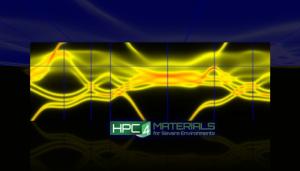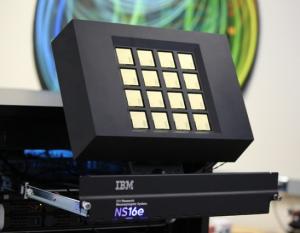LAB REPORT
Science and Technology Making Headlines
Sept. 29, 2017


Hydrogen molecules (gray) dissociate on exposed magnesium (blue) layers of magnesium diboride and migrate to boron (green) edge sites to form borohydride units (BH4, center, light green and light gray).
On the highway to hydrogen storage
An inexpensive and useful layered superconductor compound also may be an efficient solid-state material for storing hydrogen. The Department of Energy’s Energy Materials Network consortium approach to accelerate material discovery and development is starting to pay off.
Through theory and experimentation, Lawrence Livermore National Laboratory scientists discovered the key mechanism by which magnesium diboride (MgB2) absorbs hydrogen and provided key insights into the reaction pathway that converts MgB2 to its highest hydrogen capacity form, magnesium borohydride (Mg(BH4)2). Mg(BH4)2 is a particularly promising hydrogen storage material because of its high hydrogen content and attractive thermodynamics.
“The insights provided by our study are a major step toward unlocking the potential of this material for solid-state hydrogen storage,” said Keith Ray, LLNL physicist and lead author of a paper featured on the inside cover of the September issue of Physical Chemistry Chemical Physics.


The new High Performance Computing for Materials (HPC4Mtls) Program aims to reduce the cost and time spent on development, as well as increase performance of materials in severe environments, potentially saving industry millions of dollars.
It’s a material world
Lawrence Livermore will be part of a multi-lab effort to apply high-performance computing to U.S.-based industry's discovery, design and development of materials for severe environments.
The High Performance Computing for Materials Program (HPC4Mtls) will connect industry with the world-class computational resources and assets of the DOE national laboratories. It is sponsored by the DOE Office of Fossil Energy (FE), and is borne out of the department-wide HPC4Energy Innovation Initiative to advance energy technologies through high-performance computing. LLNL is the lead laboratory for the HPC4Mtls program, which includes Los Alamos, Oak Ridge and the National Energy Technology Laboratory.
“This forward-looking initiative builds on our efforts with other national labs to apply the Department of Energy’s unique leadership computing capabilities to advance forefront science and technology,” said LLNL Director Bill Goldstein. “Through the HPC4Manufacturing and HPC4Energy programs, we've shown that high-performance computing can have broad, real-world impact.”


A new 3D printing technique, developed at Lawrence Livermore, could allow scientists to print glass that incorporates different refractive indices in a single flat optic, making finishing cheaper and easier. Photos by Jason Laurea/LLNL.
Break on through
3D printing tech has been making waves for over a decade and a team of LLNL researchers have recently achieved a breakthrough in optical research: 3D printed glass.
Specifically, the researchers showed how they could use 3D printing to synthesize glass. That’s a big deal, especially considering that it allows the creation of previously impossible structures of glass. Naturally, this could be a huge step forward in the field of optical research.
There have been other attempts at 3D printing glass, but they rely on using molten glass. The researchers at LLNL used custom inks made from suspended glass particles instead, allowing them to print at room temperature. Because of this, scientists can now print glass that flattens different refractive indices down to a single flat optic.


The 16-chip IBM TrueNorth platform Lawrence Livermore will receive later this week. The scalable platform will process the equivalent of 16 million neurons and 4 billion synapses and consume the energy equivalent of a hearing-aid battery -- a mere 2.5 watts of power. Photo courtesy of IBM
Chipping away at the brain
Intel Labs has developed a neuromorphic processor that researchers believe can perform machine learning faster and more efficiently than that of conventional architectures like GPUs or CPUs. The new chip has been in development for six years.
Intel is not the only one working on neuromorphic silicon. IBM Research has developed TrueNorth, a brain-inspired chip that was introduced in 2014. It has 1 million neurons and 256 million synapses spread across 4,096 cores and is currently under trial at Lawrence Livermore Laboratory and the U.S. Air Force.
It also is being studied by more than 40 universities, government labs and businesses. The chip has been used for image and speech recognition problems, and according to IBM has exhibited accuracy on par with that of existing platforms that have been tuned for these applications for some time.


Regina Soufli
Seeing her full potential
OSA fellows represent a diverse group of members who have served with distinction in the advancement of optics and photonics. Lawrence Livermore’s Regina Soufli fits to a T.
Many scientists recall the moment in childhood when they instantly decided what they wanted to do for their life's work. Though she was always inclined toward science, Soufli didn't get her flash of insight until she started graduate school.
A course in X-ray optics at the University of California, Berkeley, captured the imagination of Soufli, who went on to make short-wavelength radiation her career. Since 1999 she has worked as a physicist and principal investigator at Lawrence Livermore National Laboratory, where she has developed many X-ray and extreme-ultraviolet optical techniques and optical coatings for such diverse applications as photolithography and space imaging.





